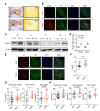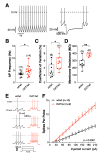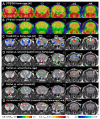Dnmt3a2/Dnmt3L Overexpression in the Dopaminergic System of Mice Increases Exercise Behavior through Signaling Changes in the Hypothalamus
- PMID: 32878077
- PMCID: PMC7504350
- DOI: 10.3390/ijms21176297
Dnmt3a2/Dnmt3L Overexpression in the Dopaminergic System of Mice Increases Exercise Behavior through Signaling Changes in the Hypothalamus
Abstract
Dnmt3a2, a de novo DNA methyltransferase, is induced by neuronal activity and participates in long-term memory formation with the increased expression of synaptic plasticity genes. We wanted to determine if Dnmt3a2 with its partner Dnmt3L may influence motor behavior via the dopaminergic system. To this end, we generated a mouse line, Dnmt3a2/3LDat/wt, with dopamine transporter (DAT) promotor driven Dnmt3a2/3L overexpression. The mice were studied with behavioral paradigms (e.g., cylinder test, open field, and treadmill), brain slice patch clamp recordings, ex vivo metabolite analysis, and in vivo positron emission tomography (PET) using the dopaminergic tracer 6-[18F]FMT. The results showed that spontaneous activity and exercise performance were enhanced in Dnmt3a2/3LDat/wt mice compared to Dnmt3a2/3Lwt/wt controls. Dopaminergic substantia nigra pars compacta neurons of Dnmt3a2/3LDat/wt animals displayed a higher fire frequency and excitability. However, dopamine concentration was not increased in the striatum, and dopamine metabolite concentration was even significantly decreased. Striatal 6-[18F]FMT uptake, reflecting aromatic L-amino acid decarboxylase activity, was the same in Dnmt3a2/3LDat/wt mice and controls. [18F]FDG PET showed that hypothalamic metabolic activity was tightly linked to motor behavior in Dnmt3a2/3LDat/wt mice. Furthermore, dopamine biosynthesis and motor-related metabolic activity were correlated in the hypothalamus. Our findings suggest that Dnmt3a2/3L, when overexpressed in dopaminergic neurons, modulates motor performance via activation of the nigrostriatal pathway. This does not involve increased dopamine synthesis.
Keywords: DNA methylation; behavioral paradigms; dopaminergic system; positron emission tomography; transgenic mouse model.
Conflict of interest statement
The authors declare no conflict of interest.
Figures





Similar articles
-
Dnmt3a2 in the Nucleus Accumbens Shell Is Required for Reinstatement of Cocaine Seeking.J Neurosci. 2018 Aug 22;38(34):7516-7528. doi: 10.1523/JNEUROSCI.0600-18.2018. Epub 2018 Jul 20. J Neurosci. 2018. PMID: 30030395 Free PMC article.
-
Effect of ghrelin on the motor deficit caused by the ablation of nigrostriatal dopaminergic cells or the inhibition of striatal dopamine receptors.Biochem Biophys Res Commun. 2018 Feb 19;496(4):1102-1108. doi: 10.1016/j.bbrc.2018.01.145. Epub 2018 Feb 1. Biochem Biophys Res Commun. 2018. PMID: 29378186
-
Stimulation effect of Dnmt3L on the DNA methylation activity of Dnmt3a2.J Biochem. 2006 Oct;140(4):553-9. doi: 10.1093/jb/mvj185. Epub 2006 Aug 31. J Biochem. 2006. PMID: 16945937
-
Reconstitution and mechanism of the stimulation of de novo methylation by human DNMT3L.J Biol Chem. 2006 Sep 8;281(36):25893-902. doi: 10.1074/jbc.M603140200. Epub 2006 Jul 7. J Biol Chem. 2006. PMID: 16829525
-
Voluntary exercise delays progressive deterioration of markers of metabolism and behavior in a mouse model of Parkinson's disease.Brain Res. 2019 Oct 1;1720:146301. doi: 10.1016/j.brainres.2019.146301. Epub 2019 Jun 18. Brain Res. 2019. PMID: 31226324 Free PMC article. Review.
Cited by
-
Roles of physical exercise in neurodegeneration: reversal of epigenetic clock.Transl Neurodegener. 2021 Aug 13;10(1):30. doi: 10.1186/s40035-021-00254-1. Transl Neurodegener. 2021. PMID: 34389067 Free PMC article. Review.
-
miR-218 Promotes Dopaminergic Differentiation and Controls Neuron Excitability and Neurotransmitter Release through the Regulation of a Synaptic-Related Genes Network.J Neurosci. 2023 Nov 29;43(48):8104-8125. doi: 10.1523/JNEUROSCI.0431-23.2023. J Neurosci. 2023. PMID: 37816598 Free PMC article.
-
TgF344-AD Rat Model of Alzheimer's Disease: Spatial Disorientation and Asymmetry in Hemispheric Neurodegeneration.J Alzheimers Dis Rep. 2023 Sep 26;7(1):1085-1094. doi: 10.3233/ADR-230038. eCollection 2023. J Alzheimers Dis Rep. 2023. PMID: 37849636 Free PMC article.
References
MeSH terms
Substances
LinkOut - more resources
Full Text Sources
Miscellaneous

